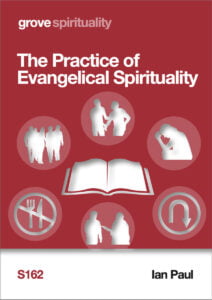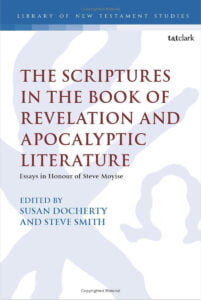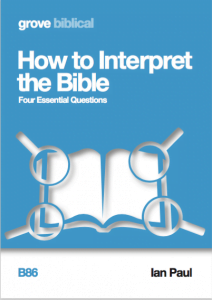The gospel lectionary reading for Trinity 15 in this Year B (the reading for Trinity 14 three years ago) is Mark 7.24-37, which includes the episode of Jesus’ encounter with the Syrophoenician woman that often brings readers up short, containing as it does what appears to be a rather shocking insult. Jesus is seeking to withdraw from public attention, needing some time for rest and recuperation, but (as characteristic of his portayal in Mark’s gospel) he is unable to keep his presence secret. A woman approaches him to ask for deliverance for her daughter and (Mark having emphasised her pagan gentile credentials), Jesus appears to insult her with a racial slur by calling her a ‘dog’. Yet her stubborn faith persists, and her clever response to Jesus’ ‘insult’ persuades him to act, so her daughter is delivered and healed.
There seems to be quite a strong trend in ‘progressive’ readings of this text to draw a particular point from this episode: Jesus was in fact fallible and racist; the woman taught him something by her response; he changed and moved on from his narrow, exclusive view; and so we should be willing to do the same. Here is one example, which sees mainstream readings of this texts as ‘workarounds’ which are avoiding the awkward reality that we find in the text:
It’s one of the most unsettling passages in the New Testament. This isn’t the Jesus Christians like to think about. This is Jesus apparently insulting and dehumanizing a desperate woman seeking the health of her family. This is Jesus writing Gentiles off as second-tier citizens…Jesus’ statement was full of prejudice and ethnocentrism.
This story calls us to confront Jesus’ humanity. Being human means being embedded in a culture. It means growing up with a certain worldview. It means inheriting traditions and language and biases—biases that can be wrongheaded and hurtful and alienating. Biases like the exclusion of Gentiles from the community of faith and the circle of those deserving compassion…
You see, Jesus doesn’t cling to his prejudice. He listens…Jesus listens. And he changes his mind…The hero of this story is not Jesus, but the Syrophoenician woman…Jesus had prejudices from his community that were magnified by his insulation from those who could challenge his views, but he listens when those views are challenged. He concedes his erroneous ethnocentrism and turns divine compassion toward all people everywhere. Jesus shows us in this story that inheriting bias is inevitable, but holding onto it is a choice.
There is no end to the wonderful ironies in this reading, not least that it is actually Mark, the writer of the gospel, who is the real hero, since he can see more clearly than Jesus did at the time the importance of this lesson. We need to pause to recognise which ‘ethnocentric’ and racist community Jesus belongs to here, whose ingrained prejudices he inherits. And it is not too difficult to read the agenda of this commentator: conservative Christians are like the ignorant, prejudiced Jesus at the beginning of the story, but progressive Christians like me are like the enlightened Jesus at the end of the story. The goal here is less for us to be like Jesus so much as to be like the commentator. We can perhaps forgive this approach, knowing that the author is a third-year undergraduate in law (not theology) at Harvard. But others take a similar line:
Jesus uttered an ethnic slur. To dismiss a desperate woman with a seriously sick child…Jesus holds all the power in this exchange. The woman doesn’t approach with arrogance or a sense of entitlement associated with wealth or privilege. Rather she comes to him in the most human way possible, desperate and pleading for her daughter. And he responds by dehumanizing her with ethnic prejudice, if not bigotry. In our modern terms, we know that power plus prejudice equals racism…
Rather than being part of the solution to ethnic prejudice, Jesus seems to be very much part of the problem, according to this story. When confronted with the gentile pagan in this story, he explains that his message and ministry are for Israelites only, a comment of ethnic exclusion and prejudice that calls to mind a similar refrain from a more modern time – whites only – that reverberated throughout the South not too long ago.
This, I think, is the great lesson of the Syrophoenician woman. It teaches us the dynamics of power and prejudice, of how even the best of humanity — the Incarnation himself — can get caught up in systems of oppression, in a culture of supremacy. Like many of us today, Jesus would have been reared into a prejudiced worldview.
So don’t tell me you aren’t prejudiced or don’t exercise your position of power through the lens of your prejudice. Even Jesus did that.
The more I think about it, the more alarming this reading is. Apart from its extraordinary historical ignorance (Jewish culture was in a position of power and dominance over against Graeco-Roman pagan culture—really?!), the writer appears entirely unaware of his dangerous characterisation of Jewish first-century culture as racist, effectively likening Jesus the Jew to a member of the Ku Klux Klan. An editorial note at the end of the piece suggests that writer (ordained in the Episcopal Church in the US) is aware of some of the difficulties here. But he doesn’t seem aware of his assumption that Jesus’ humanity implies Jesus’ prejudice and sin, or that that might have been debated by the early church, or that it contradicts some explicit claims of the NT about Jesus (‘tempted like us, but without sin’ Heb 4.15), or that knowing that Jesus lived within a particular time and culture need not imply that Jesus was trapped in that time and culture.
A rather witty post from a Catholic priest picks up some of the problems here:
Dear Rev. Know-it-all,
I heard some theologian or other say that in the Gospel a few weeks ago the Syrophoenician woman who asked Jesus to heal her daughter ended up teaching Jesus to be more tolerant. Is this possible that Jesus was a narrow-minded bigot who had to learn a thing or two from a Lebanese lady? Please help!
Kay Nanite [see Matt 15.22]
Dear Kay,
I wouldn’t worry too much. Whoever said this must be just a pop theologian. They come and go like the fins on a sixties’ Buick. If he’s Fr. WOW! today, he’ll probably be Fr. Who? tomorrow… I don’t mean to sound fussy, but the reason I call the fellow a pop theologian is that he can’t be much of scholar. He hasn’t read the text. Pop theologians always assume that their opinion is unquestionable, so they never question it themselves…
Jesus left the throne He shared with His Father, taking off the prerogatives of divinity like a garment which He left on the heavenly throne. He humbled himself for love of His Father and for love of us. He never ceased to be God, the Son of God. He never ceased to be the eternal second person of the Holy Trinity. He never ceased to be perfect, since the perfection of the God is sacrificial love. In his humanity, Jesus certainly learned. The creator of the world learned carpentry form St. Joseph and Jesus, the Word of God learned Aramaic on His Blessed Mother’s lap. But he did not learn to be less racist from a Canaanite woman. He did not learn moral truth from anyone. He was and is moral truth. The only instruction that Jesus needed was the Father’s voice, and this He always heard clearly, despite what you may have heard to the contrary.
This final comment is perhaps jumping too quickly from text to theology, so let’s spend a few moments with the text itself. First, as Ben Witherington notes in his socio-rhetorical commentary (Eerdmans, 2001, p 231), this passage is indeed challenging—so much so that it is ‘nearly impossible’ to imagine that the story was invented by Mark’s mostly gentile community. In other words, this passage helps to address a challenge from a previous generation, that the gospel stories are unreliable historically and largely a creation of the early Christian community.
But (as R T France highlights in his excellent NIGTC commentary), the episode also exhibits many connections with early and following parts of Mark. The episode begins in Mark 7.24 with the phrase ‘he rose and went from that place’, a phrase that first occurred in Mark 1.35 (though the parallel is obscured in some English translations). In both cases Jesus is seeking solitude as a prelude to the widening of his missions into new regions. Secondly, it is a feature of this early part of Mark that Jesus is moving beyond and then back into Jewish territory, which is part of the force of the eight occurrences of Jesus ‘crossing the lake’ (an aspect of Mark’s ‘fishy’ gospel in which, probably under the influence of Peter as his eye-witness source, Mark gives prominent attention to fishing, boats, and sea crossings). Thirdly and more particularly, Jesus has already been involved in deliverance ministry amongst non-Jewish pagans, in healing the Gerasene demoniac. If the woman is teaching Jesus something about traversing ethnic boundaries, it appears that neither Jesus nor the woman (nor apparently Mark) has read the episode from two chapters early. Or perhaps it is just the ‘progressive’ commentators who have forgotten to do so…
In fact, this episode fits with a number of themes in this section of Mark. ‘Bread’ is a repeated theme, first occurring in the feeding of the five thousand in Mark 6.35–44, then recurring in the feeding of the four thousand in Mark 8.1–10, as well as featuring in Jesus warning to the disciples about the Pharisees, highlighting the disciples’ own lack of understanding, in Mark 8.14–21. In each place, bread stands for the blessings of the Messiah’s ministry, first to his own people the Jews and then (secondly) to the Gentiles. The two feeding episodes function as (if you will pardon the pun) a sandwich to the encounter with the Syrophoenician woman.
So when we read the text carefully, and read it in the context of the wider arc of Mark’s narrative, what do we learn?
Misunderstandings of the pericope spring largely from the failure to read it as a whole. It is a dialogue within which the individual sayings function only as part of the whole, and are not intended to carry the weight of independent exegesis on their own. The whole encounter builds up to the totally positive conclusion of verses 29 to 30, while the preceding dialogue serves to underline the radical nature of this new stage in Jesus’s ministry into which he has allowed himself to be ‘persuaded’ by the woman’s realism and wit. He appears like a wise teacher who allows, and indeed incites, his pupil to mount a victorious argument against the foil of his own reluctance. He functions as what in a different context might be called a ‘devil’s advocate’, and is not ‘disappointed’ to be defeated in argument. As a result the reader is left more vividly aware of the reality of the problem of Jew-gentile relations, and of the importance of the step Jesus here takes to overcome it. (France, p 296).
It is worth noting here that the core issue—that of the nature of the gospel including both Jew and Gentile—remains as forceful as ever, but without having to mangle the text and turn Jesus into a bigoted racist to make the point. It turns out that Mark is a rather more compelling interpreter of Jesus’ ministry than a number of 21st-century readers. And in this careful reading, it is neither Jesus nor the woman who are the ‘hero’ in contrast to the failure and obstinacy of the other, but both who are important and rounded characters in the narrative. Jesus’ encounters with individuals are never a zero-sum game.
Some similar points are made in a much more detailed narrative-critical study of the episode by David Rhoads (Journal of the American Academy of Religion, Vol. 62, No. 2 (Summer, 1994), pp. 343-375):
The episode of the Syrophoenician woman fits tightly into the overall story, particularly in relation to the presentation of the Kingdom of God. The establishment of God’s rule over the world is the force which drives the whole plot of the narrative. Here are four ways in which this episode relates to the kingdom of God in Mark.
Rhoads highlights the way in which the woman’s response is a mirrored foil to Jesus, cleverly continuing the riddle that he offers her.
In her response, the Syrophoenician woman extends Jesus’ riddle. She does not oppose what Jesus has said. Rather, she develops the scenario of Jesus’ allegory so that she and her daughter have a place in it…Thus, in her response, the Syrophoenician woman not only stays within the Jewish perspective of Jesus’ riddle; she even refers to the Jewish children with a term of endearment.
It is perhaps worth noting how this pattern of ‘to the Jew first, then to the Gentile’ (Romans 1.16) might have been critically important if Mark’s gospel was written in the context of Rome, where relations between Jew and gentile Christian might have been tense.
When we interpret the episode in light of the themes of the whole story, we are also able to see more clearly the rhetorical impact this story may have had on an ancient audience as a boundary-crossing narrative.
And there are further points worth noting, some of detail and others of the broader context. First, Jesus calls the woman a κυνάριον, a pet, house or lap dog, who is part of the family, and not a κύων, a wild street dog. The first term occurs only here and in the parallel in Matt 15.26–27; the second occurs in the other well-known references, Matt 7.6, Luke 16.21, Phil 3.2, 2 Pet 2.22 and Rev 22.15, and can have the metaphorical meaning of prostitute.
Secondly, although the woman is identified explicitly by Mark as a ‘gentile’ (literally, ‘a Greek’), she does not appear to be of low social status, and might well have seen herself as socially superior to Jesus, a Jew. Her status might be indicated by the fact that her daughter is lying on a κλίνη, which is sometimes translated as ‘couch’, though the word is used flexibly (for example, in Luke 5.18, though not in Mark 2.4), so I am not sure this is decisive.
Thirdly, we need to pay attention to the community context in which Jesus is operating. Colin Edwards commented on a previous posting of this analysis:
Kenneth Bailey does a good job in explaining that Jesus is a setting that is community in action (as opposed to individualistic), and that Jesus usually has the disciples and his community to the fore of his attention. Therefore Bailey argues that Jesus is working with the woman to have her help him teach the watching disciples that the kingdom is for all. He doesn’t need pursuading but his disciples and watching community do. This interaction is an object lesson that helps pursuade and teach them.
And Andrew Symes notes the importance of this in the parallel in Matthew 15:
If Mark’s version is an abbreviation of Matthew 15:21-28, then Matthew’s version helps with the interpretation, because it shows the disciples seeing the woman as annoying, and trying to get Jesus to send her away. Is it too fanciful to imagine him making the comments about dogs looking at the disciples with a raised eyebrow, inviting them to agree with his pretend-racist and misogynistic assessment, and then winking at the woman, who comes out with her brilliant line about crumbs from the table?
Again in Matthew’s version, Jesus prefaces his announcement of healing with “woman, you have great faith”. Jesus honours a foreign woman and heals her daughter at a distance; he is showing up his disciples for xenophobia, lack of compassion and lack of faith; at the same time he demonstrates the intention of the kingdom for racial inclusivity and the blessing of all nations based around faith in Christ. All in an exchange which would have lasted less than a minute. The disciples come out badly, and someone can perhaps enlighten me as to why Mark’s account isn’t as clear as Matthew’s, but Jesus remains the perfect Lord and Saviour, preaching and demonstrating the kingdom in a very human setting.
I think the answer to the last question might be found in Matthew’s strongly Jewish perspective, which makes the lesson even more important.
Finally, Jesus’ approach here fits well with God’s dealings with his people, as Daniel Boehm commented previously:
To me it seems that in this passage Jesus uses a similar pedagogical method to Jahweh allowing/challenging Abraham (Gen 18:22-33) and Moses (Ex 32:7-14; Num 14:5-20) to be “obnoxious” and persistent intercessors. It seems at first reading that their patience and mercy is greater than God’s, and yet it is God stretching and shaping them to stand in the gap between himself and his people…
In this I see a connection to Lk 11:5-24 and Lk 18:1-8 where God allows himself to be compared to rather unpleasant chracters, because as we intercede we wrestle with (our image of) God. Again, not to ‘convince’ him to be merciful but to train us to trust in his justice and mercy against all odds. To me it would be one of the most joyful moments if one of my children told me – “Dad, I know you better than that.” … reminding me of who I aspire to be.
Does all this mean that Jesus is never ‘learning and growing’ in the accounts in the gospels? After all, isn’t that part of what it means to be human? Jesus was clearly not omniscient (‘no-one knows the hour, not even the Son’ Matt 24.36) and that was part of his finitude as fully human in the incarnation. But if ‘in him the fulness of the godhead dwelt bodily’ then I think we are getting into serious problems if we think he didn’t understand God’s purposes for humanity, and in particular if he was limited in his understanding by a certain kind of Jewish ethnocentricity which would equate to what we could consider ‘racism’. Apart from another else, it questions Jesus’ own understanding of the OT, which includes some very clear critiques of such a narrow view.
Besides, a careful attention to what the text actually says here offers no grounds for believing that Jesus was ignorant and racist, and that this incident taught him something about the kingdom of God that he did not already know.
It is, perhaps, worth asking why the ‘progressive’ readings of the story are so popular, given that they don’t actually pay attention to the details of the text, and given that they raise such serious theological problems in the understanding of the humanity of Jesus? Perhaps they are simply the manifestation of ignorance—of lack of awareness of lack of willingness to engage with scholars like R T France. Again, there is an irony writ large in commentating on a passage like this about boundary crossing if commentators are not willing to cross a few boundaries, to engage with theologians from other traditions, themselves. But such views are broadcast very effectively by social media, and take root in shallow soil where the reading of good commentaries by church leaders is less and less common.
But there is perhaps also a more explicit agenda—to challenge ‘orthodox’ understandings of who Jesus is, by taking the ‘risky’ step of thinking that the Jesus we find in the New Testament isn’t actually a model for us, but is frail, ignorant and sinful too. This then means that the teaching of the New Testament is not binding on us, but is part of the ‘trajectory’ of development which continues through history, so that we, now, represent the pinnacle of revelation, and our own understandings reveal the true wisdom of God.
Sadly, this ‘gospel’ doesn’t actually turn out to be very persuasive. As one comment expressed is on the second blog quoted above:
If I didn’t already have nothing but utter contempt for Christ, the bible and Christianity this exposure of Christ’s racism and bigotry surely would have rocked my world view.
If we are going to draw the crowds, perhaps we need to pay more attention to the real Jesus of the gospels.
Come and join Ian and James as they discuss these issues—and seem to have great fun doing so!

 Buy me a Coffee
Buy me a Coffee




























Indeed Ian, what a load of malarkey suppositions can be.
Provocation is a good word study and comes in various forms and applications of which there are many instances in Scripture.
God was provoked by the Israelites which God declares is “putting Him to the test”.
It is used by God to test the Israelites He brought them into “this wilderness to test you and try you whether you would [completely and utterly] worship me”.
Here Jesus tested the woman as to the genuineness of her plea and desire.
Satan is a provoker from the beginning saying “Has God [really] said” an initial provocation towards doubt; Which sad to say is a common provocation these days which often engenders febrile comments;
Often pulling down ,not edifying.
Our old Principal would often say “The Devil is God’s Chief Tester of Boilers” to see if they are fit vessels.
All this and more are described in the Old and New Testaments.
How do we provoke Christian people, and to what end or issue, how are they built up to maturity[perfection]?
2 Chronicles 32:31
Sometimes the Lord says nothing to test us. But one has to have a relationship to know when someone has gone quiet. And between ourselves, sometimes it’s better not to answer a fool in his folly, lest we be like him.
Indeed Steve, but there is also a time to answer a fool!
It is question of who, context and discernment is it not.
And I don’t always get it right.
And there is a point where it may become quarrelsome, which proverbs and other scripture has something to say about.
How do we respond when Jesus holds up the mirror of the whole canon of scripture to us as fools?
Q, Is Jesus being racist…?
A. No.
Q. Is the Good News of God incarnate, in the person of Jesus, being racist…?
A. No.
Isn’t part of the problem with reading this passage that we come with a very particular image of Jesus in our heads, and it’s quite artificial. Much like the gentle Jesus meek and mild is at odds with the account of Jesus throwing the moneychangers out of the Temple, we can have a tendency to have an image of Jesus as a sort of unemotional angelic robot doling out profound pearls of wisdom and healing people. That contrasts somewhat with the Jesus who provides more wine at the wedding at Canaan, or playfully calls Zacchaeus down from the tree. The best sermon I ever heard on the account of the Syro-Phoenician woman took the Andrew Symes stance: this is Jesus using humour to make his point. Calling the woman a dog (even a lapdog) isn’t a nice thing, but in the story she plays along. Why? Well that makes sense if you think Jesus isn’t being serious with the “insult”, and is actually teaching his audience – the Disciples.
As an aside this ought to be quite an important passage for Anglicans – it’s the basis of the Prayer of Humble Access in the Eucharist (“we are not worthy to gather the crumbs under your table” etc.).
I am perfectly happy to accept that Jesus was interacting cheekily with the woman and maybe with his disciples as you say, but I think it’s a little unfair to assume that anyone who thinks that Jesus is engaged in learning is refusing to engage with the text in order to suit their own theological agenda. The text does have Jesus calling Gentiles dogs. Although your point about two words for dog is helpful.
So,
1. Did this actually take place in space, time and history?
2.Did Jesus really say this?
3. Is it an accurate, reliable eyewitness account and record?
4. Or a mere parable?
Yesx4
Extrapolating from this scenario to other similar instances…
Is it an absolute truth that those who make a shipwreck of their faith are completely lost or is this an example of Paul using the same ploy as Jesus did with the Syrophonetian woman? (1 Tim 1:19)
And, did Paul call all Cretans bad words to get dialogue started? (Titus 1:4)
Penelope – well, it would never have occurred to me that the slur was aimed at Gentiles. We are indeed informed by the author that the woman in question was Syrian Phoenecian: Jesus does not allude to this aspect of her at all when he says ‘toss it to the dogs’.
I always took the passage to indicate that it was the Syrian Phoenecian woman who was a person of faith (in contrast to others). By her reply, she indicates that she really is a woman of faith (i.e. that she belongs to the number of the Saviour’s family – one of the ‘children’ if you like).
If Jesus uses a ‘slur’ to refer to us, then he is well within his rights – Romans 3:12 informs us that all have turned away and become ‘worthless’. We’re not just rendered unworthy (in the sense that sin has caused a few rough edges that have to be repaired – but nevertheless with some essential basic decency); sin has rendered us ‘worthless’ – so worthless as we stand, that Jesus had to undergo the crucifixion and resurrection to bring something of value to us.
In this context – given the extent to which we have fallen and what he has to do for us – I’d say that Jesus has every right to say whatever he likes. Only those who have failed to understand their own sinnerhood would dare to give Jesus marks out of ten, pick him up on language, try to tell us that he is on a ‘learning curve’ etc ….
And yes – the ‘theological agenda’ is very important – the theological agenda is getting saved (going to heaven and being in communion with God when we pass from this life to the next).
Dorothy Sayers ‘ The man born to be king’ recording has a interesting and moving account of this from the woman’s perspective that I have often played when this reading comes up
And indeed in TMBTBK, the woman is also Pilate’s wife’s masseuse and witnesses to her, perhaps prompting Pilate’s wife’s dream. (I love Sayers’ imaginative creativity.)
The Dog concept is not merely a cultural issue it is God’s estimation and designation well known through out the Ancient Scriptures eg
NASB 1995
“You shall not bring the hire of a harlot or the wages of a dog into the house of the LORD your God for any votive offering, for both of these are an abomination to the LORD your God.
New International Version has
You must not bring the earnings of a female prostitute or of a male prostitute into the house of the LORD your God to pay any vow, because the LORD your God detests them both
Revelation 22:15
New International Version
Outside are the dogs, those who practice magic arts, the sexually immoral, the murderers, the idolaters and everyone who loves and practices falsehood.
Amplified Bible
Rev.22 v 15
Outside are the dogs [the godless, the impure, those of low moral character] and the sorcerers [with their intoxicating drugs, and magic arts], and the immoral persons [the perverted, the molesters, and the adulterers], and the murderers, and the idolaters, and everyone who loves and practices lying (deception, cheating)
Revelation 21:8,27
But the fearful, and unbelieving, and the abominable, and murderers, and whoremongers, and sorcerers, and idolaters, and all liars, shall have their part in the lake which burneth with fire and brimstone: which is the second death…
1 Corinthians 6:9,10
Know ye not that the unrighteous shall not inherit the kingdom of God? Be not deceived: neither fornicators, nor idolaters, nor adulterers, nor effeminate, nor abusers of themselves with mankind, …
Philippians 3:2
Beware of dogs, beware of evil workers, beware of the concision.
The language and idiom of the Biblical texts is rooted in the culture of the time. It is absurd to think that the authors of texts you are referencing are referring to literal dogs. It is a metaphor which uses the way that in many places the (street) dogs were held in low regard to refer disparigingly to a certain type of person.
The ‘cynics’ of Greek philosphy were called that for a similar reason: they ran about with their noses to the ground like dogs (the word comes from the Greek kuōn).
In our own culture, some call another person a “bitch”, or “son of a bitch”. No actual canines are involved.
Also, had you picked up that the Greek word in Mark 7:27,28 is the word kunarion which means, according to the lexicons something like a “puppy”, or a “pet dog”, which why it is in the house and gets food from under the table. Such a pet dog is clearly regarded differently from a kuōn. Translations which fail to make this distinction are at fault.
With reference to your last paragraph, I want to say “yes” but also …
Surely to call someone a “little dog” or “puppy” or “household pet” albeit possibly in a fond way, is still to place them as lesser to the children in the passage, even if it is to provoke a person to question and arrive at the conclusion that nobody is beyond God’s grace.
No, I don’t think that is the case. I found this conclusion very helpful:
In that context, it appears that Jesus did not insult or dehumanize the woman, but instead invited her into His household. She understood the overture and responded to it in a humble and clever way, accepting the bread of life which was being dropped from the table of children of Israel. (Remember that Jesus went to Tyre after having been confronted by Judean religious scribes for eating bread with unclean hands.) Her willingness to take the historic role of loyal gentile, like Caleb (or like the former Tyronian King Hiram, who had a close trading relationship with David) caused Him not just to accept her but to elevate her using an honorific which is only used of one other woman in the New Testament, Jesus’ mother Mary.
from https://www.christianpost.com/news/was-jesus-really-racist-against-the-syrophoenician-woman.html
Ian – this, in the context, just doesn’t make sense. because she has come to ask Jesus nicely to heal her daughter, and Jesus has basically replied ‘no’. The discussion as to whether Jesus had communicated this in a nice way, which was politically correct and wouldn’t upset the professional offence-takers, or whether he had communicated it in a nasty way is very much a secondary issue – she had come to Jesus to ask for healing for her daughter and the initial response looks negative (because it is negative – his initial response is not, ‘of course I’ll heal your daughter – do not worry about a thing’).
Where those who accuse Jesus of racism get it wrong is that they make a connection which the author of the text does not make – where they suggest that he might have responded differently (and healed the daughter without a murmur) to someone of a different race. The point where ‘race’ comes into the text is that the woman, by her response, showed that she had great faith – and the gospels quite pointedly indicate that great faith was to be found in the Gentile community (e.g. the Roman centurion of Matthew 8).
But in Mark 7, with his first response is actually a refusal and, given who he is (he is the Word of Life, with the ability to cast out demons and cure all illnesses) this initial response does have a nasty ring to it (irrespective of whether or not ‘dog’ has bad connotations, or extremely nice connotations).
Final thoughts on provocation along with
some of Festus Etuwewe’s thoughts @
cocgrey.com/provoke-one-another-to-love-and-good-works/
What is good and what is bad Provocation?
We nearly always associated the word provoke with fights and disputes. We most often hear the word when one nation provokes another nation into war; one party provokes the other into retaliation
Hebrews 10:24 turns this phrase around,
Beloved let us consider how to provoke[stir up] one another to love and good works,,
The Bible is constantly offering us opportunities to get out of the old patterns of retaliation so that something good may emerge even in a bad situation. When someone does something negative, our respond should be positive..
What is the real meaning of the word provoking? It means to call out. What do we call out? we call out something within another. Each of us has some bad stuff within, but the Bible urges us to call out the good—our best desires, hopes and dreams and behaviors out of each other instead.
“To provoke” is to excite, arouse, or call into action. Christians sometimes need to be incited, stimulated, or aroused to a good thing. Too often we are more inclined to irritate one another rather than to incite or stimulate each other to that which is good.
. Verse 24: “Let us consider how to stimulate one another to love and good deeds.”
Here is the focus for your life. Here is what you aim at from morning till night as a Christian.
Notice carefully: it is not what you might expect. It is not: consider how to love each other and do good deeds. That would be Biblical and right. But it’s different:
“Consider how to stimulate each other to love and good deeds.”
I associate the term good deeds with the term Faith for
“Without faith it is impossible to be well pleasing in God’s eyes.”
Provocation is not backward but forward looking;
“but exhorting one another, and so much the more as you see the Day approaching”.
We must Love God first, Christians need to be stirred up to love God more. But how much is “more”? Jesus answers, “with all your heart, with all your soul, and with all your mind” (Matt. 22:37). We should love God more than our parents, relatives and friends (Matt. 10:37). More than food, our source of daily livelihood, or whatever has to do with this life (Matt. 6:33).
We must love each other more. The law had required that one love his neighbor as himself (Lev. 19:18), and Jesus gives this as the second greatest commandment of the law (Matt. 22:39). But how much “more” should Christians love each other? Peter answers, keep growing in love until you “love one another fervently with a pure heart” (1 Pet. 1:23).
Paul remind us of our calling and our role in the church
“For we are His workmanship, created in Christ Jesus for good works, which God prepared beforehand that we should walk in them” (Eph. 2:10).
God wants his people to be working, and he wants others to see their good works (not just their good moral life) and glorify him in heaven (Matt. 5:16).
Provoking others in the right way, is a positive thing that incites action and inspires determination. It galvanizes and stirs up hope and energy so that others can get moving in the right direction to achieve better things.
Influencing and encouraging others to reach higher and to go further, is one of the most powerful expressions of our love for our neighbor. At the heart of doing this effectively is example, example, example.
Who are we exciting in our Church’s apart from our own limited echo chambers.
Thanks very much for this post, Ian; very helpful for Sunday’s sermon. As you say, the theme of bread/food through these chapters 6 – 8 is really significant: 16 out of 19 uses in Mark compared to John: 17 of the 20 uses are in Chapter 6 alone.
In Mk 3: 8 Jesus is already shown as teaching people from Tyre and Sidon, so the ‘ethnically exclusive Jesus who learns to be more inclusive’ view can’t be correct. It’s the place that is significant here – outside Israel but Israel’s God is just as present and active there.
Any thoughts on the significance of Jesus ‘entering a house’ in the region of Tyre? It was either the house of a member of the Jewish diaspora showing Jesus hospitality (more likely in my view) so the woman showed great courage in entering it and the householder & disciples may have been deeply offended by her presence. Or it was the house of a Gentile (less likely in my view) so Jesus demonstrated his openness to Gentiles in entering it. In either case he would have shared food/bread with the householder and their family.
I wonder how much we miss here because there are no ‘stage directions’ in the text to give the tone of voice or facial expressions used by Jesus or the woman. Surely she might giving an audaciously witty response to a male Jewish rabbi? They can give radically different meanings to words that are hard to interpret just by themselves in a text – Symes’ ‘raised eyebrow’ point. Lots of communication and humour depends on this kind of subtlety which we simply can’t know from the text. In a family there are nuances of meaning that non-members don’t grasp because they don’t share the culture.
There’s also a great contrast drawn between her trust and urgency and the lack of faith of the disciples and the Jewish leaders in Mark.
Bailey’s point is really helpful. Even today people are eagle-eyed when a leader says or does something, as children are e.g. in a school setting. The disciples and household are a hidden audience here which Jesus would have been very aware of but which is invisible in the text.
I think the point about whether and how Jesus learned and what learning may have meant for him and how it relates to his full divinity is really complex, not least because learning is a multi-faceted and time and culture-bound experience. I suggest that we simply don’t have enough information of the right kind in the gospels to make a definitive judgement about what or how he learned, especially what he learned reflexively from his experience in preaching the kingdom across Palestine.
I wonder if your contrast between a binding New Testament teaching and a dangerous ‘trajectory’ which wanders away from the New Testament isn’t as clear as you suggest. Not all trajectories go in the wrong direction. Part of the teaching of the NT, and indeed the OT, may be in the very trajectories they work with internally and to which we can be faithful by continuing them. A trajectory needn’t be up to a pinnacle or an improvement but rather along in the same direction that the NT sets, which is pretty close to the use of didomi in the NT (e.g. 1 Cor 11) and some more Roman Catholic understandings of tradition. Just a thought . .. Thanks again.
Ian, I’m not quite happy with the baldness of your ‘Jesus wasn’t omniscient.’ Geoff Grogan explored this (in the chapter on the credal issue, significantly) in ‘The Xt of the Bible and the Church’s faith’ p.240. Our Lord didn’t know the date of his second advent, yet if he was God he must have known everything. How can absolute knowledge and limited knowledge coexist? Geoff proposed something like his omniscience normally being subconscious. There’s a parallel in the so-called Calvinist extra.
Surely as a human being on earth he was limited, either by choice or by definition? If he was truly omniscient as a physical human being, would his head not have exploded, subconscious or not?!
Jesus seemed to wait on his Father for information at any given turn. He had no need to know anything except to know He would be given instruction through the Spirit.
steve – yep – that’s what I infer from the centurion of Matthew 8. The centurion had understood this – and understood that Jesus would not have been doing the things he was doing if he wasn’t in the Father and doing the Father’s will.
Jesus wasn’t omniscient in his humanity. He was baptised into our sin (although he was without sin) in his humanity (Sinclair B Ferguson). He was anointed with Holy Spirit, (and as a corollary in his humanity, His gifts?) and he was self aware of who he was, his ministry, the purpose of his life, and the scriptures and their flow (OT at that time), their continuity and discontinuity in Him?
thanks to all for your help
The language and idiom of the Biblical texts is rooted in the culture of the time.[David Wilson]
Are the words of God subject to cultural norms &forms or was the culture informed by God’s words?.
From begining to end God’s words & precepts are consistent.
Paul clearly taught “beware of dogs” firmly rooted in sound [heathy]doctrine.
The words of Jesus, he claimed, were His Father’s words,He spoke nothing “from Himself. He venerated and was consistent with the Scriptures[Witness the wilderness temptations]
No scripture is for private interpretation.
The problem that I have with some forensic disecting of a word of scripture is that it seems as though Jesus is made subject to the psychiatrist couch.
Similarly the Scriptures; whether written by Mark or Micky Mouse are realy in fact “breathed by God”and thus profitable for sound [Healthy] doctrine
Alas the prophetic word declares that in the end people will not endure sound doctrine but will turn to novel ideas of man centered teachers.
It was the practice and resposabilityof some in the early church to search [the whole
scriptures [at that time only the OT,] to see if these things belong to God.
Alan – you sometimes have good information. Could you indicate (if you have it off-hand) the circumstances that Jesus particularly commends people for their great faith? And since an ugly element of racism has been thrust upon us – divide them up into Jew and Gentile?
I can think of one other example – the centurion in Matthew 8 (a Roman – and by implication Gentile). In that example, he indicated that he understood that he knew exactly who Jesus was and where he got his power from (namely, by being absolutely obedient to God the Father).
In Mark 7, the Syrian Phoenician woman similarly proved by her response that she had got the point …..
There’s also the bleeding woman in Luke 8 (one of my favourites).
Hi Jock
Perhaps, Mark 10 v47 – 52 blind Bartimaeus, the son of Timaeus, sitting by the way side begging. Might fall within your category, if only for his persistence.[As the woman]
However, I do admire your point, great faith is not so common even amongst those who have a bible near to hand. As someone once opined,
“Don’t tell me about your doubts, tell me about your Certainties, I have enough doubts of my own!”
Doubt your doubts. Tim Keller
Wow…you’ve all completely lost the plot!
The passage about the Syrophonecian woman is about our Father’s business, not yours.
His business can be summarised as…Creation in perfection turned to ruination…Repair that ruination by creating a new people and sending a Messiah through them to teach first the new people and then the rest (hence there shall be one fold and one shepherd, for he had other sheep not of that new fold).
Yeah sure, big J compared her ilk to a mutt, but its just words not sticks n stones, and words don’t break bones…but her words showed that she knew and understood our Father’s plan to restore his creation to perfection.
However, her girl was terminally ill and her mum knew she wouldn’t last long enough to wait for the evangelism to the rest of his fold. She needed immediate doctoring and she got it by her faith.
You are all become purblind through your theology, tradition and habits.
Thanks—but ‘all’? All who?